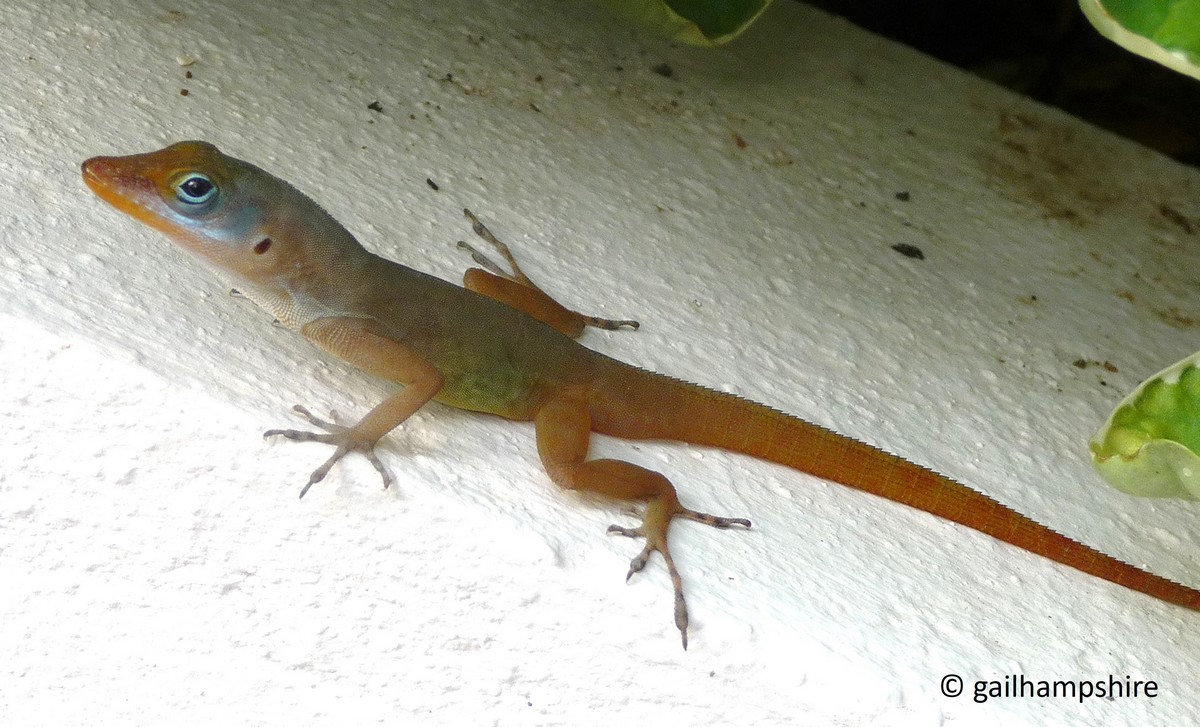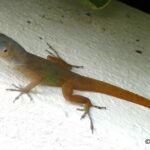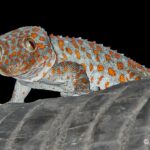
- Scientific name : Anolis wattsii (Boulenger, 1894)
- Common name: Watts’ anole.
- Order : Dactyloidae
- Family : Squamata
Description
Morphology. Medium sized anole. The body colour is brown or olive, with or without darker transversal stripes. The head is reddish, with bluish marks. The ventral side varies from beige to yellow, and the dewlap from white to yellow, to orange.
Standard body size (snout-vent length). males: 39 to 58 mm; females: 36 to 46 mm.
Sexual dimorphism. Only males have a dewlap.
Females are darker than males, with brown-grey body colour, and may present light stripes in the middle of the back and on the flanks.
Variations. The body colour of the same individual can vary from light to dark, depending on its physiological condition.
Possible confusion with other species.
Distribution
Native. Antigua (including satellite islets).
Introduced. Caribbean: Saint Lucia (Daltry, 2009; Krauss, 2010), Trinidad (White and Hailey, 2006; Fiji and Auguste, 2017).
Biology and ecology
Habitat. Anolis wattsii is able to inhabit most Caribbean terrestrial habitats, from the coastal environments to humid highland forests. The species is also observed in anthropized habitats (Daltry, 2009).
Diet. Insectivore and frugivore (Daltry, 2009).
Reproduction. Reproduction happen throughout the year. The female lays a single egg at one or two weeks intervals (Daltry, 2009).
Behaviour. Males may extend their dewlap in order to defend their territory, or when looking for a breeding partner.
Impact and management of introduced populations
Impact. In Saint Lucia, the presence of Anolis wattsii resulted in a reduced populations of the native species, A. luciae (Williams et al., 2019).
Management. To date, no targeted control measures have been established in the different regions where the species has been introduced.
Bibliographie
- Giannasi, N., Thorpe, R. S., & Malhotra, A. (1997). Introductions of anolis species to the islan of St. Lucia, West Indies: testing for hybrids using multivariate morphometrics. Journal of Herpetology, 31, 586–589.
- Gorman, G. C. (1976). Observations on the distribution of Anolis extremus (Sauria: Iguanidae) on St. Lucia, West Indies: a “colonizing” species. Herpetologica, 32, 184–188.
- Losos, J. B. (1996). Dynamics of range expansion by three introduced species of anolis lizards on Bermuda. Journal of Herpetology, 30, 204–210.
- Murphy, J. C., Downie, J. R., Smith, J. M., Livingstone, S. M., Mohammed, R. S., Lehtinen, R. M., … Jowers, M. J. (1997). A field guide to the Amphibians & Reptiles of Trinidad & Tobago (R. J. Auguste, ed.). Malabar, Florida: Krieger Publishing Compagny.
- Nummelin, M. (1997). Seasonal occurrence of juvenile Anolis extremus Garman in forest patches in Barbados. Journal of the Barbados Museum and Historical Society, 43, 24–31.
- Rivas, G. A., Molina, C. R., Ugueto, G. N., Barros, T. R., Barrio-Amorós, C. L., & Kok, P. J. R. (2012). Reptiles of Venezuela: An updated and commented checklist. In Zootaxa, 64.
- Williams, R. J., Morton, M. N., Daltry, J. C., & Toussaint, A. (2019). The distribution of non-native Anolis lizards on Saint Lucia, Lesser Antilles. Caribbean Journal of Science, 49, 281.





